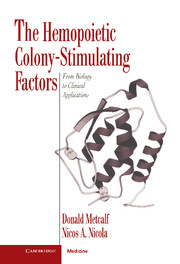Book contents
- Frontmatter
- Contents
- Preface
- 1 Historical introduction
- 2 General introduction to hemopoiesis
- 3 Key techniques in analyzing hemopoiesis
- 4 Biochemistry of the colony-stimulating factors
- 5 Biochemistry of the colony-stimulating factor receptors
- 6 Molecular genetics of the colony-stimulating factors and their receptors
- 7 Biological actions of the colony-stimulating factors in vitro
- 8 The biology of colony-stimulating factor production, degradation, and clearance
- 9 Actions of the colony-stimulating factors in vivo
- 10 Role of the colony-stimulating factors in basal hemopoiesis
- 11 Actions of the colony-stimulating factors in resistance to infections
- 12 Role of the colony-stimulating factors in other disease states
- 13 The colony-stimulating factors and myeloid leukemia
- 14 Clinical uses of the colony-stimulating factors
- 15 Conclusions
- References
- Index
1 - Historical introduction
Published online by Cambridge University Press: 04 August 2010
- Frontmatter
- Contents
- Preface
- 1 Historical introduction
- 2 General introduction to hemopoiesis
- 3 Key techniques in analyzing hemopoiesis
- 4 Biochemistry of the colony-stimulating factors
- 5 Biochemistry of the colony-stimulating factor receptors
- 6 Molecular genetics of the colony-stimulating factors and their receptors
- 7 Biological actions of the colony-stimulating factors in vitro
- 8 The biology of colony-stimulating factor production, degradation, and clearance
- 9 Actions of the colony-stimulating factors in vivo
- 10 Role of the colony-stimulating factors in basal hemopoiesis
- 11 Actions of the colony-stimulating factors in resistance to infections
- 12 Role of the colony-stimulating factors in other disease states
- 13 The colony-stimulating factors and myeloid leukemia
- 14 Clinical uses of the colony-stimulating factors
- 15 Conclusions
- References
- Index
Summary
Erythropoietin was the first humoral regulator of hemopoietic cells to be recognized and was discovered in the serum in 1906 as a consequence of some simple in vivo experiments on rabbits made anemic by bleeding (Carnot and Deflandre, 1906). While the purification of erythropoietin - from anemic human urine - was not completed until 70 years later (Miyake et al., 1977), extensive studies using impure preparations of erythropoietin were performed in animals during the 1950s and 1960s.
It was assumed that erythropoietin would be the prototype of comparable regulators for hemopoietic cells in other lineages. However, despite extensive in vivo studies using manipulated animals and tissue extracts, in the 60-year period until the mid-1960s, no convincing evidence was produced for the existence of comparable regulators.
The 30 years since that time have seen a major change in this situation, because at least 20 hemopoietic regulators have now been characterized. This has been achieved by the use of tissue-cultured hemopoietic cells to provide initial bioassay systems. For each of these regulators, only subsequently was it possible to undertake experiments in animals to verify the biological actions of the regulator. Initially during this period, the discovery process required the purification by separative biochemistry of the active factors from medium conditioned by tissues or cell lines. More recently, this method of discovery has been progressively supplanted by the initial detection of new regulators by direct expression screening of cDNA pools, using cell lines as bioassays. Furthermore, the biochemical characterization of the active molecules has been made from recombinant protein, which has then been used to establish the action of the regulator on normal cells.
- Type
- Chapter
- Information
- The Hemopoietic Colony-stimulating FactorsFrom Biology to Clinical Applications, pp. 1 - 9Publisher: Cambridge University PressPrint publication year: 1995
- 4
- Cited by

